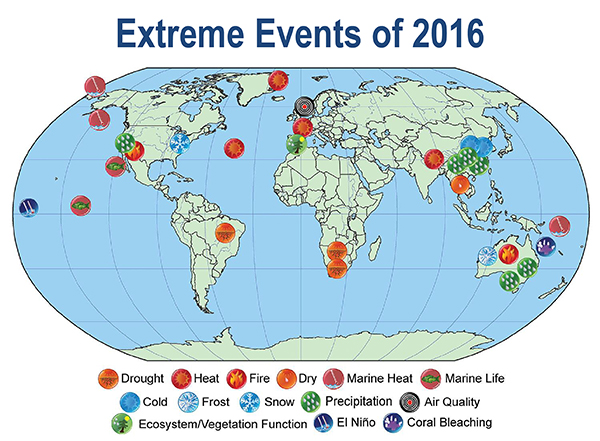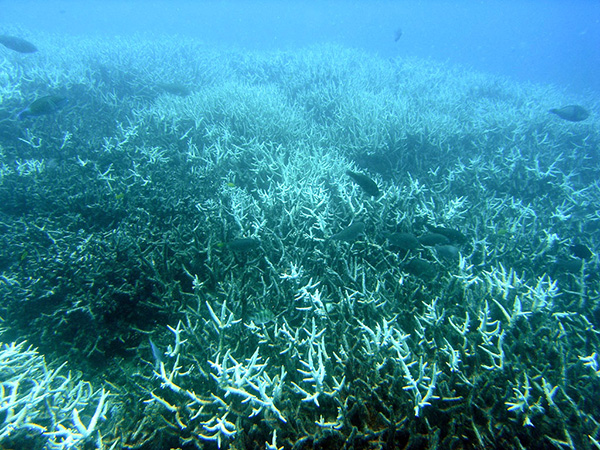
by Harvey Leifert Thursday, December 14, 2017

Most of the extreme weather events of 2016 were found to have been caused by or exacerbated by human-induced climate change. Credit: AMS/NOAA.
Three extreme weather events that occurred in 2016 would not have been possible in Earth’s pre-industrial climate, according to the sixth annual report on the attribution of extreme weather events issued Dec. 13 by NOAA and the American Meteorological Society (AMS). This marks the first time that researchers have concluded that a specific weather event would not have been possible without the influence of humans.
The three unprecedented events were 2016’s record global heat, extreme heat over Asia, and a “blob” of unusually warm water in the Bering Sea. Most of the other events analyzed in the 27 peer-reviewed papers considered in the report were made more severe by climate change, although that was not the events’ principal cause, the scientists reported in a press conference at the fall meeting of the American Geophysical Union in New Orleans this week. Three of the studied events were found to have no role from human-influenced climate change.
The report “marks a fundamental change,” said Jeff Rosenfeld, editor-in-chief of the Bulletin of the American Meteorological Society, at the press conference. In the past, he said, the severity of some weather events, or their likelihood of occurring, was known to be amplified by climate change, but these are the first confidently identified events that could not have occurred at all prior to the era of human-influenced climate change.
However, it is unlikely that these were actually the first events to have been caused by climate change, said Stephanie Herring of NOAA, editor of the 2017 report and its five annual predecessors explaining extreme events from a climate perspective, at the press conference. The report’s authors note that researchers had predicted that human influence would at some point become sufficiently strong to push events beyond the bounds of natural variability alone. They add that scientists will now revisit some weather events of prior years, to determine whether those of 2016 were in fact the first of their kind or simply the first to be conclusively linked.
With regard to overall global warming, Thomas R. Knutson of NOAA and colleagues determined that the record warmth of 2016 would not have been possible under climate conditions of the early 1900s. “Anthropogenic forcing was a necessary condition,” based on simulations using sophisticated climate models, they wrote in the report. Natural variability, including El Niño, played a relatively small role, they said.
“All of the risk of the extremely high temperatures over Asia in 2016 can be attributed to anthropogenic warming,” wrote Yukiko Imada of the Japan Meteorological Agency and colleagues in the report, adding that El Niño contributed to a further regional increase of warm events in parts of Southeast Asia and the Philippines.
“The warmth of the Bering Sea in 2016 was unprecedented in the historical record,” according to John E. Walsh of the University of Alaska, Fairbanks, and colleagues, writing in the report. An ensemble of five climate models concluded that the 2016 anomaly cannot be explained without anthropogenic climate warming. Internal variability played a supplementary role, they noted.

The longest, most widespread and most damaging global coral bleaching event on record occurred at Australia's Great Barrier Reef in 2016, due in part to ocean warming caused by human activity. Credit: Acropora, CC BY-SA 3.0
“Climate change may actually be altering what we think of as natural variability,” Herring said. In addition to the three events cited above, the report authors note that others were strengthened by human-caused climate change, including “the longest, most widespread, and most damaging global coral bleaching event on record” at Australia’s Great Barrier Reef. The main cause was ocean warming due to human activity, and it was exacerbated by El Niño.
About two-thirds of the 131 total papers considered in the six NOAA-AMS reports have identified a role for climate change in the events studied. For the 2017 report, 21 of the 27 papers described climate change as a significant driver of that extreme weather event.
© 2008-2021. All rights reserved. Any copying, redistribution or retransmission of any of the contents of this service without the expressed written permission of the American Geosciences Institute is expressly prohibited. Click here for all copyright requests.